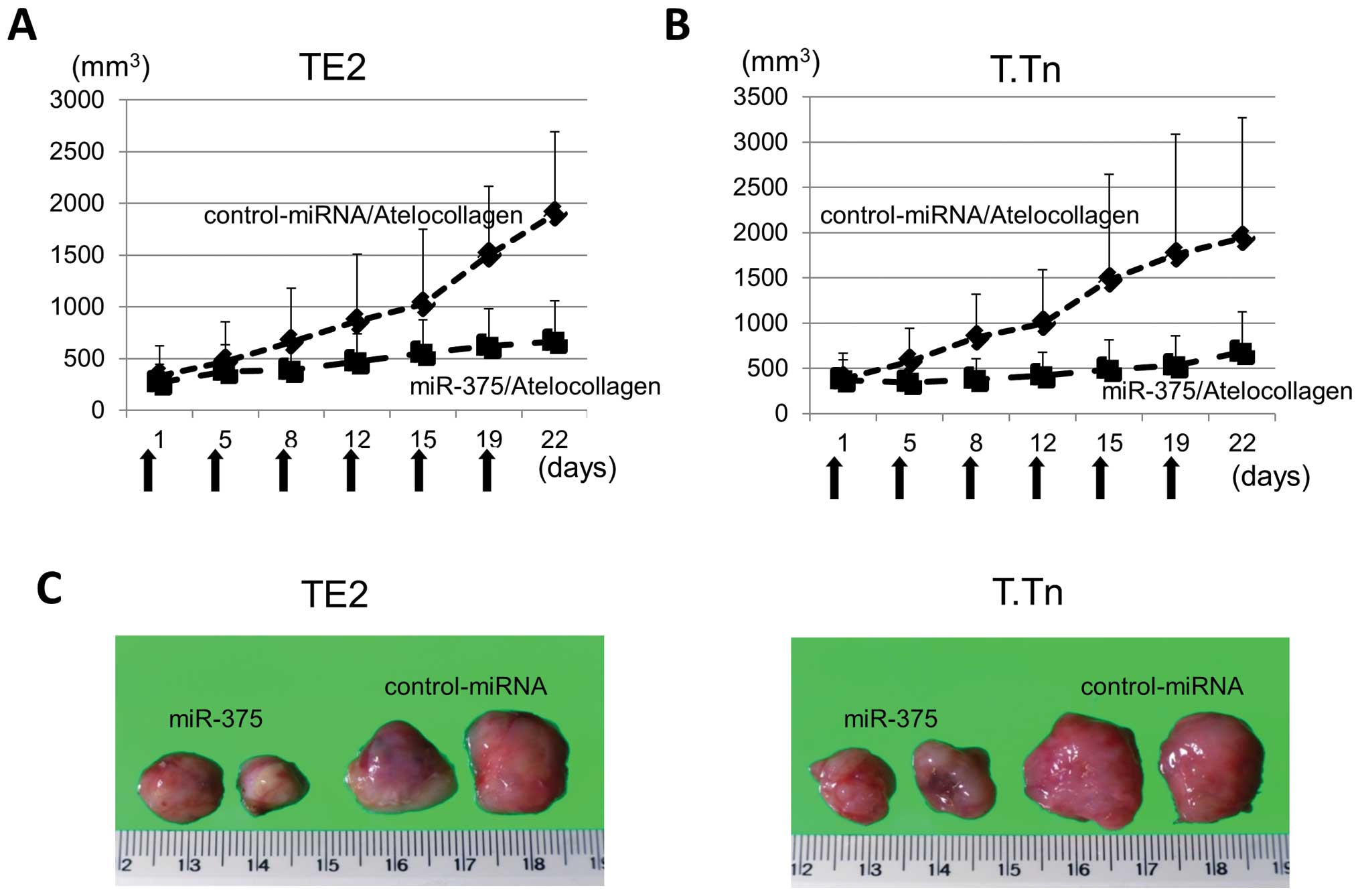|
1
|
Ruol A, Castoro C, Portale G, et al:
Trends in management and prognosis for esophageal cancer surgery:
twenty-five years of experience at a single institution. Arch Surg.
144:247–254. 2009. View Article : Google Scholar : PubMed/NCBI
|
|
2
|
Morita M, Yoshida R, Ikeda K, et al:
Advances in esophageal cancer surgery in Japan: an analysis of 1000
consecutive patients treated at a single institute. Surgery.
143:499–508. 2008. View Article : Google Scholar : PubMed/NCBI
|
|
3
|
Hoshino I and Matsubara H: MicroRNAs in
cancer diagnosis and therapy: from bench to bedside. Surg Today.
43:467–478. 2013. View Article : Google Scholar
|
|
4
|
Hoshino I, Matsubara H, Akutsu Y, et al:
Gene expression profiling induced by histone deacetylase inhibitor,
FK228, in human esophageal squamous cancer cells. Oncol Rep.
18:585–592. 2007.PubMed/NCBI
|
|
5
|
Hoshino I, Matsubara H, Hanari N, et al:
Histone deacetylase inhibitor FK228 activates tumor suppressor
Prdx1 with apoptosis induction in esophageal cancer cells. Clin
Cancer Res. 11:7945–7952. 2005. View Article : Google Scholar : PubMed/NCBI
|
|
6
|
Hoshino I and Matsubara H: Recent advances
in histone deacetylase targeted cancer therapy. Surg Today.
40:809–815. 2010. View Article : Google Scholar : PubMed/NCBI
|
|
7
|
Bartel DP: MicroRNAs: genomics,
biogenesis, mechanism, and function. Cell. 116:281–297. 2004.
View Article : Google Scholar : PubMed/NCBI
|
|
8
|
Hua Z, Lv Q, Ye W, et al: MiRNA-directed
regulation of VEGF and other angiogenic factors under hypoxia. PLoS
One. 1:e1162006. View Article : Google Scholar
|
|
9
|
Nissan T and Parker R: Computational
analysis of miRNA- mediated repression of translation: implications
for models of translation initiation inhibition. RNA. 14:1480–1491.
2008. View Article : Google Scholar : PubMed/NCBI
|
|
10
|
Eulalio A, Huntzinger E, Nishihara T,
Rehwinkel J, Fauser M and Izaurralde E: Deadenylation is a
widespread effect of miRNA regulation. RNA. 15:21–32. 2009.
View Article : Google Scholar :
|
|
11
|
Xu X, Chen Z, Zhao X, et al: MicroRNA-25
promotes cell migration and invasion in esophageal squamous cell
carcinoma. Biochem Biophys Res Commun. 421:640–645. 2012.
View Article : Google Scholar : PubMed/NCBI
|
|
12
|
Kinoshita T, Nohata N, Yoshino H, et al:
Tumor suppressive microRNA-375 regulates lactate dehydrogenase B in
maxillary sinus squamous cell carcinoma. Int J Oncol. 40:185–193.
2012.
|
|
13
|
Ward A, Balwierz A, Zhang JD, et al:
Re-expression of microRNA-375 reverses both tamoxifen resistance
and accompanying EMT-like properties in breast cancer. Oncogene.
32:1173–1182. 2013. View Article : Google Scholar
|
|
14
|
He XX, Chang Y, Meng FY, et al:
MicroRNA-375 targets AEG-1 in hepatocellular carcinoma and
suppresses liver cancer cell growth in vitro and in vivo. Oncogene.
31:3357–3369. 2012. View Article : Google Scholar
|
|
15
|
Lee EJ, Gusev Y, Jiang J, et al:
Expression profiling identifies microRNA signature in pancreatic
cancer. Int J Cancer. 120:1046–1054. 2007. View Article : Google Scholar
|
|
16
|
Dettmer M, Perren A, Moch H, Komminoth P,
Nikiforov YE and Nikiforova MN: Comprehensive MicroRNA expression
profiling identifies novel markers in follicular variant of
papillary thyroid carcinoma. Thyroid. 23:1383–1389. 2013.
View Article : Google Scholar : PubMed/NCBI
|
|
17
|
Nguyen HC, Xie W, Yang M, et al:
Expression differences of circulating microRNAs in metastatic
castration resistant prostate cancer and low-risk, localized
prostate cancer. Prostate. 73:346–354. 2013. View Article : Google Scholar
|
|
18
|
Isozaki Y, Hoshino I, Nohata N, et al:
Identification of novel molecular targets regulated by tumor
suppressive miR-375 induced by histone acetylation in esophageal
squamous cell carcinoma. Int J Oncol. 41:985–994. 2012.PubMed/NCBI
|
|
19
|
Kong KL, Kwong DL, Chan TH, et al:
MicroRNA-375 inhibits tumour growth and metastasis in oesophageal
squamous cell carcinoma through repressing insulin-like growth
factor 1 receptor. Gut. 61:33–42. 2012. View Article : Google Scholar
|
|
20
|
Li J, Li X, Li Y, et al: Cell-specific
detection of miR-375 down-regulation for predicting the prognosis
of esophageal squamous cell carcinoma by miRNA in situ
hybridization. PLoS One. 8:e535822013. View Article : Google Scholar
|
|
21
|
Hu G, Wei Y and Kang Y: The multifaceted
role of MTDH/AEG-1 in cancer progression. Clin Cancer Res.
15:5615–5620. 2009. View Article : Google Scholar : PubMed/NCBI
|
|
22
|
Yu C, Chen K, Zheng H, et al:
Overexpression of astrocyte elevated gene-1 (AEG-1) is associated
with esophageal squamous cell carcinoma (ESCC) progression and
pathogenesis. Carcinogenesis. 30:894–901. 2009. View Article : Google Scholar : PubMed/NCBI
|
|
23
|
Kinoshita T, Hanazawa T, Nohata N, Okamoto
Y and Seki N: The functional significance of microRNA-375 in human
squamous cell carcinoma: aberrant expression and effects on cancer
pathways. J Hum Genet. 57:556–563. 2012. View Article : Google Scholar : PubMed/NCBI
|
|
24
|
Chen Y, Zhang H, Xu A, et al: Elevation of
serum l-lactate dehydrogenase B correlated with the clinical stage
of lung cancer. Lung Cancer. 54:95–102. 2006. View Article : Google Scholar : PubMed/NCBI
|
|
25
|
Inaba S, Nagahara S, Makita N, et al:
Atelocollagen-mediated systemic delivery prevents immunostimulatory
adverse effects of siRNA in mammals. Mol Ther. 20:356–366. 2012.
View Article : Google Scholar :
|
|
26
|
Banno H, Takei Y, Muramatsu T, Komori K
and Kadomatsu K: Controlled release of small interfering RNA
targeting midkine attenuates intimal hyperplasia in vein grafts. J
Vasc Surg. 44:633–641. 2006. View Article : Google Scholar : PubMed/NCBI
|
|
27
|
Takei Y, Kadomatsu K, Goto T and Muramatsu
T: Combinational antitumor effect of siRNA against midkine and
paclitaxel on growth of human prostate cancer xenografts. Cancer.
107:864–873. 2006. View Article : Google Scholar : PubMed/NCBI
|














